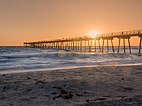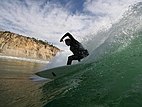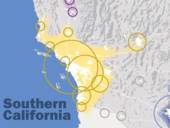Southern California
Southern California | |
|---|---|
Images top to bottom, left to right: Hermosa Beach Pier, Disneyland Resort, Village of La Jolla, Santa Monica Pier, Surfer at Black's Beach, Hollywood Sign, Downtown Los Angeles, San Diego Skyline | |
 Red: The ten counties of Southern California | |
| Country | United States |
| State | California |
| Counties | Imperial Kern Los Angeles Orange Riverside San Bernardino San Diego San Luis Obispo Santa Barbara Ventura |
| Largest city | Los Angeles |
| Area (10-county)[1] | |
• Total | 56,505 sq mi (146,350 km2) |
| Population (2020)[2] | |
• Total | 23,762,904 |
| GDP | |
| • Total | $1.95 trillion (2022) |
Southern California (commonly shortened to SoCal) is a geographic and cultural region that generally comprises the southern portion of the U.S. state of California. Its densely populated coastal region includes Greater Los Angeles (the second-most populous urban agglomeration in the United States)[4][5] and San Diego County (the second-most populous county in California). The region generally contains ten of California's 58 counties: Los Angeles, San Diego, Orange, Riverside, San Bernardino, Kern, Ventura, Santa Barbara, San Luis Obispo, and Imperial counties.
Although geographically smaller than Northern California in land area, Southern California has a higher population, with 23.76 million residents as of the 2020 census. The sparsely populated desert region of California occupies a significant portion (part of which has even been proposed to be split into a new county due to cultural, economic and geographic differences relative to the rest of the more urban region) of the area: the Colorado Desert, along with the Colorado River, is located on Southern California's eastern border with Arizona, and the Mojave Desert shares a border with Nevada to the northeast. Southern California's southern border with Baja California is part of the Mexico–United States border.
Constituent metropolitan areas
[edit]Southern California encompasses eight metropolitan areas (MSAs), three of which together form the Greater Los Angeles Combined Statistical Area (CSA) with over 18 million people, the second-biggest CSA after the New York CSA. These three MSAs are the Los Angeles metropolitan area (Los Angeles and Orange counties, with 13.3 million people), the Inland Empire (Riverside and San Bernardino counties, including the Coachella Valley cities, with 4.3 million people), and the Oxnard–Thousand Oaks–Ventura metropolitan area (0.8 million people). In addition, Southern California contains the San Diego metropolitan area with 3.3 million people, Bakersfield metro area with 0.9 million, and the Santa Barbara, San Luis Obispo, and El Centro (Imperial County) metropolitan areas.
The Southern California Megaregion (or megalopolis) is larger still, extending northeast into Las Vegas, Nevada and south across the Mexican border into Tijuana.[6]
Significance
[edit]

Within Southern California are two major cities, Los Angeles and San Diego, as well as three of the country's largest metropolitan areas.[7] With a population of approximately 4 million, Los Angeles is the most populous city in California and the second most populous in the United States. South of Los Angeles and with a population of approximately 1.4 million is San Diego, the second most populous city in the state and the eighth most populous in the nation.

The counties of Los Angeles, San Diego, Orange, Riverside, and San Bernardino are the five most populous in the state, and are among the top 15 most populous counties in the United States.[8]
The motion picture, television and music industry are centered in the Los Angeles area in Southern California. Hollywood, a district of Los Angeles, gives its name to the American motion picture industry, which is synonymous with the neighborhood name. Headquartered in Southern California are The Walt Disney Company (which owns ABC), Sony Pictures, Universal Pictures, MGM, Paramount Pictures, and Warner Bros. Universal, Warner Bros., and Sony also run major record companies.
Southern California is also home to a large surf and skateboard culture. Companies such as Vans, Volcom, Quiksilver, No Fear, Stüssy, RVCA, and Body Glove are all headquartered there. Skateboarder Tony Hawk; surfers Rob Machado, Timmy Curran, Bobby Martinez, Pat O'Connell, Dane Reynolds, and Chris Ward live in Southern California. Some of the most famous surf locations are in Southern California as well, including Trestles, Rincon, The Wedge, Huntington Beach, and Malibu. Some of the world's largest action sports events, including the X Games,[9] Boost Mobile Pro,[10] and the U.S. Open of Surfing, are held in Southern California. The region is also important to the world of yachting with premier events including the annual Transpacific Yacht Race, or Transpac, from Los Angeles to Hawaii. San Diego Yacht Club hosted the three America's Cup races from 1988 to 1995. The first modern-era triathlon was held in San Diego's Mission Bay in 1974. Since then, Southern California, and San Diego in particular, have become a mecca for triathlon and multi-sport racing, products, and culture.
Southern California has multiple sports franchises and networks, such as Fox Sports Net.
Many of these locals and tourists frequent the Southern California coast for its beaches. Some of Southern California's most popular beaches are Malibu, Laguna Beach, La Jolla, Manhattan Beach, and Hermosa Beach. Southern California is also known for its mountain resort communities, such as Big Bear Lake, Lake Arrowhead, and Wrightwood, and their ski resorts, like Bear Mountain, Snow Summit, Snow Valley Mountain Resort, and Mountain High. The inland desert city of Palm Springs is also popular.[11]
Northern boundary
[edit]
Southern California is generally considered the area of California south of the latitude 35°45',[12] approximately one-third of the state, formed by the northern boundaries of San Luis Obispo, Kern, and San Bernardino counties, which are not exactly a straight line. Another definition for Southern California uses Point Conception and the Tehachapi Mountains as the northern geographical barriers, especially when defining California's bioregions.[13][14] In this definition, Owens Valley and Death Valley are part of the Southern California desert system.[15] Because of the barrier formed by the Tehachapi and Sierra Nevada ranges, cartographer George Wheeler observed in 1876 that Northern California was better connected to Oregon and Nevada than it was to Southern California.[16]

Following the acquisition of the territory of California by the United States, several pro-slavery politicians attempted to arrange the division of Alta California at 36 degrees, 30 minutes, the line of the Missouri Compromise. Instead, the passing of the Compromise of 1850 enabled California to be admitted to the Union as a free state, preventing the southern half of California from becoming its own separate slave state.
Subsequently, Californians (dissatisfied with inequitable taxes and land laws) and pro-slavery Southerners in the lightly populated "cow counties" of Southern California attempted three times in the 1850s to achieve a separate statehood or territorial status separate from Northern California. The last attempt, the Pico Act of 1859, was passed by the California State Legislature and signed by State Governor John B. Weller. It was approved overwhelmingly by nearly 75 percent of voters to form the proposed Territory of Colorado. This territory was to include a portion of the much larger Tulare County and all of San Luis Obispo County. The proposal was sent to Washington, D.C., with a strong advocate in Senator Milton Latham. However, the secession crisis following the election of Abraham Lincoln in 1860 and the subsequent American Civil War led to the proposal never coming to a vote.[17][18]
In 1900, the Los Angeles Times defined Southern California as including "the seven counties of Los Angeles, San Bernardino, Orange, Riverside, San Diego, Ventura, and Santa Barbara." This definition left out San Luis Obispo and Kern counties.[19]
Southern California was the name of a proposed new state which failed to get on the 2018 California ballot. The ballot measure proposed splitting the existing state into three parts.[20]
In December 2020, during the COVID-19 pandemic, the state government led by Governor Gavin Newsom divided the state into five regions for the purpose of issuing stay-at-home orders. The Southern California region consisted of the following counties: Imperial, Inyo, Los Angeles, Mono, Orange, Riverside, San Bernardino, San Diego, San Luis Obispo, Santa Barbara, and Ventura. However, Kern County was grouped with other counties of the San Joaquin Valley, California's central agricultural valley.[21]
| County Ref. |
Population | Land mi2[22] |
Land km2 |
Pop. /mi2 |
Pop. /km2 |
|---|---|---|---|---|---|
| Los Angeles County[23] | 10,014,009 | 4,059.28 | 10,513.49 | 2,466.94 | 952.49 |
| San Diego County[24] | 3,298,634 | 4,210.23 | 10,904.45 | 783.48 | 302.50 |
| Orange County[25] | 3,186,989 | 792.84 | 2,053.45 | 4,019.71 | 1,552.02 |
| Riverside County[26] | 2,418,185 | 7,209.27 | 18,671.92 | 335.43 | 129.51 |
| San Bernardino County[27] | 2,181,654 | 20,068.01 | 51,975.91 | 108.71 | 41.97 |
| Kern County[28] | 909,235 | 8,134.65 | 21,068.65 | 111.77 | 43.15 |
| Ventura County[29] | 843,843 | 1,840.79 | 4,767.62 | 458.41 | 176.99 |
| Santa Barbara County[30] | 448,229 | 2,733.94 | 7,080.87 | 163.95 | 63.30 |
| San Luis Obispo County[31] | 282,424 | 3,300.85 | 8,549.16 | 85.56 | 33.03 |
| Imperial County[32] | 179,702 | 4,175.54 | 10,814.60 | 43.04 | 16.62 |
| Southern California | 23,762,904 | 56,525.40 | 146,400.11 | 420.39 | 162.31 |
| California | 39,538,223 | 155,959.34 | 403,932.84 | 253.52 | 97.88 |
Urban landscape
[edit]This article needs additional citations for verification. (July 2011) |

Southern California consists of a heavily developed urban environment, home to some of the largest urban areas in the state, along with the Deserts of California (part of which was even proposed to become a new county due to cultural, economic and geographic differences relative to the rest of the more urban region)[33][34][35] that have been left undeveloped. It is the third most populated megalopolis in the United States, after the Great Lakes megalopolis and the Northeast megalopolis. Much of Southern California is famous for its large, spread-out, suburban communities and use of automobiles and highways. The dominant areas are Los Angeles, Orange County, San Diego, and Riverside–San Bernardino, each of which are the centers of their respective metropolitan areas, composed of numerous smaller cities and communities. The urban area is also host to an international San Diego–Tijuana metropolitan region, created by the urban area spilling over into Baja California.
The main barrier to urbanization along the Interstate 5 corridor is Camp Pendleton. The cities and communities along Interstate 15 and Interstate 215 are so interrelated that Temecula and Murrieta have as much connection with the San Diego metropolitan area as they do with the Inland Empire. To the east, the United States Census Bureau considers the San Bernardino and Riverside County areas, Riverside-San Bernardino area as a separate metropolitan area from Los Angeles County. Newly developed exurbs formed in the Antelope Valley, north of Los Angeles, the Victor Valley, and the Coachella Valley with the Imperial Valley. Also, population growth was high in the Bakersfield-Kern County, Santa Maria, and San Luis Obispo areas.
Climate
[edit]
Most of Southern California has a Mediterranean-like climate, with warm and dry summers, mild and wet winters, where cool weather and freezing temperatures are rare. Southern California contains other types of climates, including semi-arid, desert and mountain, with infrequent rain and many sunny days. Summers are hot or warm, and dry, while winters are mild, and rainfall is low to moderate depending on the area. Rain is infrequent, but is often heavy when it does occur, making flash floods an aspect of living in Southern California. This climatic pattern was alluded to in the hit song "It Never Rains (In Southern California)". While snow is very rare in lower elevations, mountains above 5,000 feet (1,500 m) receive plentiful snowfall in the winter.
Since the first decade of the 21st century, droughts and wildfires have increased in frequency as a result of climate change.[36][37]
Natural landscape
[edit]

Southern California consists of one of the more varied collections of geologic, topographic, and natural ecosystem landscapes in a diversity outnumbering other major regions in the state and country. The region spans from Pacific Ocean islands, shorelines, beaches, and coastal plains, through the Transverse and Peninsular Ranges with their peaks, and into the large and small interior valleys, to the vast deserts of California.
- Introductory categories include:
- Category: Beaches of Southern California
- Category: Mountain ranges of Southern California
- Category: Rivers of Southern California
- Category: Deserts of California
- Category: Parks in Southern California
Geography
[edit]Geographic features
[edit]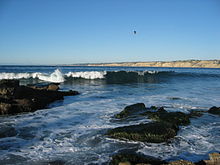

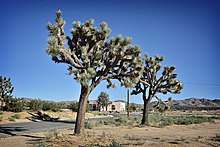

- Algodones Dunes (Imperial County)
- Angeles National Forest (Los Angeles, San Bernardino, & Ventura Counties)
- Antelope Hills (Kern County)
- Antelope Valley (Los Angeles & Kern Counties)
- Arroyo Seco (Los Angeles County)
- Bacon Hills (Kern County)
- Baldwin Hills (Los Angeles County)
- Ballona Wetlands (Los Angeles County)
- Big Bear Lake (San Bernardino County)
- Bissell Hills (Kern County)
- Black Hills (Kern County)
- Bolsa Chica Estuary (Orange County)
- Buena Vista Hills (Kern County)
- Buena Vista Lake (Kern County)
- Cajon Pass (San Bernardino County)
- Calico Mountains (San Bernardino County)
- Channel Islands (Santa Barbara, Ventura & Los Angeles Counties)
- Castaic Lake (Los Angeles County)
- Chino Hills (Orange, Los Angeles, Riverside & San Bernardino Counties)
- Coachella Valley (Riverside County)
- Colorado Desert (San Bernardino, Riverside, Imperial, & San Diego Counties)
- Colorado River (San Bernardino, Riverside & Imperial Counties, Baja California & Sonora)
- Conejo Valley (Los Angeles & Ventura Counties)
- Cucamonga Valley (San Bernardino & Riverside Counties)
- Cuyamaca Mountains (San Diego County)
- Death Valley (San Bernardino & Inyo Counties)
- Diablo Range (Kern County)
- Diamond Valley Lake (Riverside County)
- Elk Hills (Kern County)
- Elkhorn Hills (San Luis Obispo County)
- El Mirage Lake (San Bernardino County)
- El Paso Mountains (Kern County)
- Gaviota Coast (Santa Barbara County)
- Greenhorn Mountains (Kern County)
- High Desert (Los Angeles, Kern, Inyo, & San Bernardino Counties)
- Horned Toad Hills (Kern County)
- Imperial Valley (Imperial County)
- Irish Hills (San Luis Obispo County)
- In-Ko-Pah Mountains (San Diego County)
- Inland Empire (Riverside & San Bernardino Counties)
- Jacumba Mountains (San Diego County)
- Jawbone Canyon (Kern County)
- Kern River (Kern County)
- La Jolla Cove (San Diego County)
- Laguna Mountains (San Diego County)
- Lake Arrowhead (San Bernardino County)
- Lake Casitas (Ventura County)
- Lake Elsinore (Riverside County)
- Lake Isabella (Kern County)
- Lake Perris (Riverside County)
- Lake Piru (Ventura County)
- Lakeview Mountains (Riverside County)
- Lake Webb (Kern County)
- Little San Bernardino Mountains (Riverside & San Bernardino Counties)
- Little Signal Hills (Kern County)
- Los Angeles Basin (Los Angeles & Orange Counties)
- Los Angeles River (Los Angeles County)
- Los Padres National Forest (Kern, Los Angeles, San Luis Obispo, Santa Barbara, & Ventura Counties)
- Lost Hills (Kern County)
- Low Desert (Imperial, San Diego, Riverside & San Bernardino Counties)
- Mojave Desert (Los Angeles, Kern, Riverside & San Bernardino Counties)
- Mojave River (San Bernardino County)
- Mount San Antonio (Los Angeles County)
- New River (Imperial County, Mexicali Municipality)
- Nine Sisters (San Luis Obispo County)
- Ojai Valley (Ventura County)
- Orange Coast (Orange County)
- Oxnard Plain (Ventura County)
- Palomar Mountain (San Diego County)
- Palo Verde Valley (Riverside & Imperial Counties)
- Palos Verdes Peninsula (Los Angeles County)
- Panamint Range (Inyo County)
- Peninsular Ranges (San Diego, Riverside, & Orange Counties)
- Pleito Hills (Kern County)
- Point Loma (San Diego County)
- Point Mugu (Ventura County)
- Point of Rocks (Kern County)
- Pomona Valley (Los Angeles & San Bernardino Counties)
- Providence Mountains (San Bernardino County)
- Puente Hills (Los Angeles County)
- Pyramid Lake (Los Angeles County)
- Rand Mountains (Kern County)
- Rio Hondo (Los Angeles County)
- Rosamond Hills (Kern County)
- Saddleback Valley (Orange County)
- Salton Sea (Imperial & Riverside Counties)
- San Andreas Fault (All Counties)
- San Bernardino Mountains (San Bernardino County)
- San Bernardino National Forest (Riverside & San Bernardino Counties)
- San Bernardino Valley (San Bernardino County)
- San Diego Bay (San Diego County)
- San Diego River (San Diego County)
- San Emigdio Mountains (Los Angeles, Ventura, & Kern Counties)
- San Fernando Valley (Los Angeles County)
- San Gabriel Mountains (Los Angeles & San Bernardino Counties)
- San Gabriel River (Los Angeles County)
- San Gabriel Valley (Los Angeles County)
- San Jacinto Mountains (Riverside County)
- San Jacinto River (Riverside County)
- San Joaquin Valley (Kern County)
- San Luis Rey River (San Diego County)
- San Pedro Bay (Los Angeles County)
- San Rafael Mountains (Santa Barbara County)
- Santa Ana Mountains (Orange & Riverside Counties)
- Santa Ana River (San Bernardino, Riverside & Orange Counties)
- Santa Ana Valley (Orange County)
- Santa Catalina Island (Los Angeles County)
- Santa Clara River (Ventura County)
- Santa Clara River Valley (Ventura County)
- Santa Clarita Valley (Los Angeles County)
- Santa Margarita River (Riverside, Orange & San Diego Counties)
- Santa Monica Bay (Los Angeles County)
- Santa Monica Mountains (Los Angeles & Ventura Counties)
- Santa Rosa Mountains (Riverside, Imperial & San Diego Counties)
- Santa Susana Mountains (Los Angeles & Ventura Counties)
- Santa Ynez Mountains (Santa Barbara & Ventura Counties)
- Santa Ynez Valley (Santa Barbara County)
- Scodie Mountains (Kern County)
- Sequoia National Forest (Kern County)
- Shale Hills (Kern County)
- Sierra Nevada (Kern County)
- Sierra Pelona Mountains (Los Angeles & Kern Counties)
- Simi Hills (Los Angeles & Ventura Counties)
- Simi Valley (Ventura County)
- Sweetwater River (San Diego County)
- Tehachapi Mountains (Kern & Los Angeles Counties)
- Tejon Hills (Kern County)
- Temescal Mountains (Riverside County)
- Telephone Hills (Kern County)
- Temblor Range (Kern & San Luis Obispo Counties)
- Tijuana River (San Diego County)
- Topatopa Mountains (Ventura County)
- Turtle Mountains (San Bernardino County)
- Ventura River (Ventura County)
- Verdugo Mountains (Los Angeles County)
- Victor Valley (San Bernardino County)
Geology
[edit]List of major fault zones
[edit]Note: Plate boundary faults are indicated with a (#) symbol.
- Brawley Seismic Zone
- Chino Fault
- Elsinore Fault Zone
- Elysian Park Fault
- Garlock Fault
- Hosgri Fault
- Imperial Fault Zone
- Laguna Salada Fault
- Newport–Inglewood Fault
- Peninsular Ranges
- Puente Hills Fault
- Raymond Fault
- Rose Canyon Fault
- Salton Trough
- Salinian Block
- San Andreas Fault #
- San Cayetano Fault
- San Felipe Fault Zone
- San Gabriel Fault
- San Jacinto Fault Zone
- Santa Maria River Fault
- Santa Ynez Fault
- Shoreline Fault
- Ventura Fault
- White Wolf Fault
- Whittier Fault
- Yorba Linda Fault

Earthquakes
[edit]Each year, Southern California has about 10,000 earthquakes. Nearly all of them are too small to be felt. Only several hundred have been greater than magnitude (Mw ) 3.0, and only about 15–20 have been greater than Mw 4.0.[38] California as a whole enacted the Alquist Priolo Special Studies Zone Act in the wake of the 1971 San Fernando earthquake. The act prohibits new construction of residential buildings closer than 50 feet (15 m) from a surface rupturing active fault zone. In addition, the act improved safety by requiring new structures (both residential and commercial) to be seismically retrofitted. It also required existing infrastructure to comply.
Since 1972, numerous large magnitude earthquakes have struck Southern California with little widespread damage in part due to act. However, exceptions can be noted for epicenters that lie directly on top of densely populated regions such as the Mw 6.7 1994 Northridge Earthquake and, to a lesser extent, the smaller Mw 5.5 2008 Chino Hills earthquake. The Northridge earthquake occurred on a blind-thrust fault directly underneath the San Fernando Valley, which until the earthquake was previously undiscovered. Seismic retrofitting of existing and new construction is aimed to prevent damage and save lives in the aftermath of a major quake, but it cannot guarantee that buildings will be unscathed if the epicenter is relatively close by.
The 1994 Northridge earthquake was particularly destructive, causing a substantial number of deaths, injuries, and structural collapses. The quake caused the most property damage of any earthquake in U.S. history at an estimated $20 billion.[39]
Many Southern California faults are able to produce a Mw 6.7 earthquake or greater, such as the San Andreas Fault, which can produce Mw 8.0 or greater. The largest known earthquake in California was the 1857 Fort Tejon earthquake that ruptured 200+ miles (320+ kilometers) of the San Andreas Fault from Parkfield to Wrightwood. With a recurrence interval of roughly 150 years, this part of the San Andreas fault is well within its window to produce another large earthquake. Along with the southern section of the San Andreas (in the Palm Springs region, which has not ruptured in ~400 years), the entire Southern California portion of the San Andreas Fault is ready to produce a powerful earthquake in the near future.
Notable faults capable of large magnitude events include the San Jacinto Fault (a splay of the San Andreas that runs directly under the I-10 & I-215 interchange), the Newport–Inglewood-Rose Canyon Fault (located adjacent to SoFi Stadium and responsible for Signal Hill), the Elsinore Fault (created Lake Elsinore), the Garlock Fault (which marks boundary between of the Sierra Nevada and the Mojave Desert), and the Hollywood fault (which is within feet of Capitol Records and is roughly parallel to Hollywood Boulevard).
The United States Geological Survey (USGS) has released a California earthquake forecast,[40] which models earthquake occurrence in California.
List of earthquakes
[edit]This is a partial list of earthquakes in Southern California. For a full list, see List of earthquakes in California.
Note: Earthquakes with epicenters in the Los Angeles Metro Area are marked with the (#) symbol. Other earthquakes mentioned indicates shaking was felt in the region.
- 1812 San Juan Capistrano earthquake #
- 1812 Ventura earthquake
- 1857 Fort Tejon earthquake
- 1892 Laguna Salada earthquake
- 1899 San Jacinto earthquake
- 1918 San Jacinto earthquake
- 1933 Long Beach earthquake #
- 1940 El Centro earthquake
- 1948 Desert Hot Springs earthquake
- 1971 San Fernando earthquake #
- 1979 Imperial Valley earthquake
- 1968 Borrego Mountain earthquake
- 1986 North Palm Springs earthquake
- 1987 Superstition Hills earthquakes
- 1987 Whittier Narrows earthquake #
- 1991 Sierra Madre earthquake #
- 1992 Big Bear earthquake #
- 1992 Landers earthquake
- 1994 Northridge earthquake #
- 2008 Chino Hills earthquake #
- 2010 Baja California earthquake
- 2019 Ridgecrest earthquakes
Population
[edit]| Census | Pop. | Note | %± |
|---|---|---|---|
| 1850 | 6,492 | — | |
| 1860 | 33,280 | 412.6% | |
| 1870 | 44,158 | 32.7% | |
| 1880 | 91,916 | 108.2% | |
| 1890 | 251,770 | 173.9% | |
| 1900 | 337,328 | 34.0% | |
| 1910 | 808,408 | 139.7% | |
| 1920 | 1,423,786 | 76.1% | |
| 1930 | 3,044,978 | 113.9% | |
| 1940 | 3,840,733 | 26.1% | |
| 1950 | 5,931,975 | 54.4% | |
| 1960 | 9,398,722 | 58.4% | |
| 1970 | 12,103,559 | 28.8% | |
| 1980 | 14,308,742 | 18.2% | |
| 1990 | 18,269,095 | 27.7% | |
| 2000 | 20,637,512 | 13.0% | |
| 2010 | 22,680,010 | 9.9% | |
| 2020 | 23,762,904 | 4.8% | |
| Sources: 1790–1990, 2000, 2010, 2020[22][41][42] Chart does not include Indigenous population figures. Studies indicate that the Native American population in California in 1850 was close to 150,000 before declining to 15,000 by 1900.[43] | |||

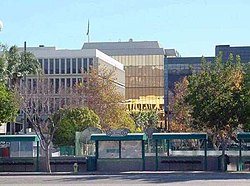
As of the 2020 United States Census, Southern California has a population of 23,762,904. Despite a reputation for high growth rates, Southern California's population has grown slower than the state average since the 2000s. This is due to California's growth becoming concentrated in the northern part of the state as result of a stronger, tech-oriented economy in the Bay Area and an emerging Greater Sacramento region.
Southern California consists of one Combined Statistical Area, eight Metropolitan Statistical Areas, one international metropolitan area, and multiple metropolitan divisions. The region is home to two extended metropolitan areas that exceed five million in population. These are the Greater Los Angeles Area at 17,786,419, and San Diego–Tijuana at 5,105,768.[44][45] Of these metropolitan areas, the Los Angeles-Long Beach-Santa Ana metropolitan area, Riverside-San Bernardino-Ontario metropolitan area, and Oxnard-Thousand Oaks-Ventura metropolitan area form Greater Los Angeles;[46] while the El Centro metropolitan area and San Diego-Carlsbad-San Marcos metropolitan area form the Southern Border Region.[47][48] North of Greater Los Angeles are the Santa Barbara, San Luis Obispo, and Bakersfield metropolitan areas.
Cities
[edit]Los Angeles (with a population of approximately 3.9 million people) and San Diego (at nearly 1.4 million people) are the two largest cities in all of California, and are among the top eight largest cities in the United States.[49] In Southern California, there are also 14 cities with more than 200,000 residents and 48 cities over 100,000 residents. Many of Southern California's most developed cities lie along or in close proximity to the coast, with the exception of San Bernardino and Riverside.
Counties
[edit]
- Imperial
- Kern
- Los Angeles
- Orange
- Riverside
- San Bernardino
- San Diego
- San Luis Obispo
- Santa Barbara
- Ventura
Politics
[edit]Presidental
[edit]Southern California has drifted left since 2004, and is solidly Democrat. Kern County remains the sole county to vote for the GOP, with Orange County having been Democrat since 2012. However, in the Trump era, Trump was able to make serious inroads in the Latino counties, resulting in flipping 3 Hispanic majority counties, Riverside, San Bernardino and Imperial.
| Year | Republican | Democratic | Third party(ies) | |||
|---|---|---|---|---|---|---|
| No. | % | No. | % | No. | % | |
| 2024 | 3,763,168 | 40.19% | 5,311,319 | 56.73% | 287,820 | 3.07% |
| 2020 | 3,717,774 | 35.86% | 6,428,890 | 62.00% | 221,737 | 2.14% |
| 2016 | 2,745,578 | 33.34% | 5,021,740 | 60.99% | 466,704 | 5.67% |
| 2012 | 2,993,945 | 39.46% | 4,417,780 | 58.23% | 175,111 | 2.31% |
| 2008 | 3,072,280 | 39.38% | 4,583,880 | 58.75% | 145,650 | 1.87% |
| 2004 | 2,795,363 | 47.16% | 3,065,072 | 51.71% | 66,762 | 1.13% |
Economy
[edit]Industries
[edit]Southern California is one of the largest economies in the United States. It is dominated by, and heavily dependent upon, the abundance of petroleum, as opposed to other regions where automobiles are not nearly as dominant, due to the vast majority of transport that runs on this fuel. Southern California is famous for tourism and the entertainment industry. Other industries include software, automotive, aerospace, finance, biomedical, ports and regional logistics. The region was a leader in the housing bubble from 2001 to 2007, and has been heavily impacted by the housing crash.
Since the 1920s, motion pictures, petroleum, and aircraft manufacturing have been major industries. In one of the richest agricultural regions in the U.S., cattle and citrus were major industries until farmlands were turned into suburbs. Although military spending cutbacks have had an impact, aerospace continues to be a major factor.[50]
Major central business districts
[edit]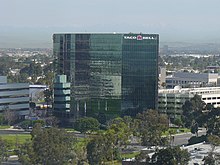
Southern California is home to many major business districts. Central business districts (CBD) include Downtown Los Angeles, Downtown Riverside, Downtown San Bernardino, downtown San Diego, and the South Coast Metro. Within the Los Angeles Area are the major business districts of Downtown Pasadena, Downtown Burbank, Downtown Santa Monica, Downtown Glendale and Downtown Long Beach. Los Angeles proper has many business districts, such as Downtown LA and those lining Wilshire Boulevard, including Mid-Wilshire, the Miracle Mile, Downtown Beverly Hills, and Westwood; others include Century City and Warner Center in the San Fernando Valley. The area of Santa Monica and Venice (and perhaps some of Culver City) is informally referred to as "Silicon Beach" because of the concentration of financial and marketing technology-centric firms located in the region.
The San Bernardino-Riverside Area maintains the business districts of Downtown San Bernardino, Hospitality Business/Financial Centre, University District which are in the cities of San Bernardino and Riverside.
In Orange County, has highly developed suburban business centers (also known as edge cities) including the Anaheim–Santa Ana edge city along I-5; and another, the South Coast Plaza–John Wayne Airport edge city that stretches from the South Coast Metro to the Irvine Business Complex; Newport Center; and Irvine Spectrum. Downtown Santa Ana is an important government, arts and entertainment, and retail district.
Downtown San Diego is the CBD of San Diego, though the city is filled with business districts. These include Carmel Valley, Del Mar Heights, Mission Valley, Rancho Bernardo, Sorrento Mesa, and University City. Most of these districts are located in Northern San Diego and some within North County regions.
Theme parks and Water parks
[edit]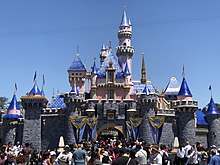
Los Angeles
- Dry Town Water Park
- Pacific Park
- Raging Waters San Dimas
- Six Flags Hurricane Harbor
- Six Flags Magic Mountain
- Universal Studios Hollywood
Orange County
Riverside & San Bernardino
San Diego
Vineyard-Winery American Viticultural Area (AVA) districts
[edit]- California wine AVA-American Viticultural Areas in southern California:
Transportation
[edit]This section needs additional citations for verification. (March 2016) |
Southern California is home to Los Angeles International Airport, the second-busiest airport in the United States by passenger volume (see World's busiest airports by passenger traffic) and the third-busiest by international passenger volume (see Busiest airports in the United States by international passenger traffic); San Diego International Airport, the busiest single-runway airport in the United States; Van Nuys Airport, the world's busiest general aviation airport; major commercial airports at San Bernardino, Orange County, Bakersfield, Ontario, Burbank, and Long Beach; and numerous smaller commercial and general aviation airports.
Six of the seven lines of the commuter rail system, Metrolink, run out of downtown Los Angeles, connecting Los Angeles, Ventura, San Bernardino, Riverside, Orange, and San Diego counties with the other line connecting San Bernardino, Riverside, and Orange counties directly.
Southern California is also home to the Port of Los Angeles, the country's busiest commercial port; the adjacent Port of Long Beach, the country's second busiest container port; and the Port of San Diego.
Airports
[edit]The following table shows all airports listed by the Federal Aviation Association (FAA) as a hub airport:[51]
| Airport | ID | City (Metro area) |
Category | Enplanements (2011) (mil) |
|---|---|---|---|---|
| Los Angeles International Airport | LAX | Los Angeles | Large Hub | 30.5m |
| San Diego International Airport | SAN | San Diego | Large Hub | 8.5m |
| John Wayne Airport | SNA | Orange County | Medium Hub | 4.2m |
| Ontario International Airport | ONT | San Bernardino, Riverside | Medium hub | 2.3m |
| Hollywood Burbank Airport | BUR | Burbank (LA) | Medium Hub | 2.1m |
| Long Beach Airport | LGB | Long Beach (LA) | Small Hub | 1.5m |
| Palm Springs International Airport | PSP | Palm Springs | Small Hub | 0.8m |
| Santa Barbara Municipal Airport | SBA | Santa Barbara | Small Hub | 0.7m |
| San Luis Obispo Regional Airport | SBP | San Luis Obispo | Small Hub | 0.5m |
| San Bernardino International Airport | SBD | San Bernardino, Riverside | Small Hub | NA |
Freeways and highways
[edit]
Sections of the Southern California freeway system are often referred to by names rather than by the official numbers.
| Sign | Interstate | Freeway name |
|---|---|---|
| Interstate 5 | Golden State Freeway Santa Ana Freeway San Diego Freeway Montgomery Freeway | |
| Interstate 8 | Ocean Beach Freeway Mission Valley Freeway | |
| Interstate 10 | Santa Monica (Rosa Parks) Freeway Golden State Freeway San Bernardino Freeway Indio (Dr. June McCarroll) Freeway Blythe Freeway | |
| Interstate 15 | Mojave Freeway Barstow Freeway Ontario Freeway Corona Freeway Temecula Valley Freeway Escondido Freeway | |
| Interstate 40 | Needles Freeway | |
| Interstate 105 | Century (Glenn Anderson) Freeway | |
| Interstate 110 | Harbor Freeway | |
| Interstate 210 | Foothill Freeway | |
| Interstate 215 | Barstow Freeway San Bernardino Freeway Moreno Valley Freeway Escondido Freeway | |
| Interstate 405 | San Diego Freeway | |
| Interstate 605 | San Gabriel River Freeway | |
| Interstate 710 | Long Beach Freeway | |
| Interstate 805 | Jacob Dekema Freeway | |
| Future Interstate 905 |
| Sign | U.S. Route | Freeway name |
|---|---|---|
| U.S. Route 66 | National Trails Highway Cajon Boulevard Foothill Boulevard Arroyo Seco Parkway Santa Monica Boulevard | |
| U.S. Route 95 | ||
| U.S. Route 99 | Golden State Highway Ridge Route | |
| U.S. Route 101 | Ventura Freeway Hollywood Freeway Santa Ana Freeway El Camino Real | |
| U.S. Route 395 |
Public transportation
[edit]
- Antelope Valley Transit Authority
- Big Blue Bus (Santa Monica)
- Gold Coast Transit (Ventura County)
- Golden Empire Transit (Bakersfield)
- Los Angeles County Metropolitan Transportation Authority
- Metrolink
- North County Transit District (northern San Diego County)
- Omnitrans (southwestern San Bernardino County)
- Orange County Transportation Authority
- Riverside Transit Agency (western Riverside County)
- Coaster (Oceanside to San Diego)
- San Diego Metropolitan Transit System
- San Luis Obispo Regional Transit Authority
- Santa Barbara MTD
Communication
[edit]Telephone area codes
[edit]- 213 – Central Los Angeles
- 310 – West Los Angeles, Inglewood, Santa Monica, South Bay and Catalina Island
- 323 – Overlay with 213
- 424 – Overlay with 310
- 442 – Overlay with 760
- 562 – Long Beach, Gateway Cities, and parts of northern Orange County
- 619 – most of San Diego County including San Diego
- 626 – most of San Gabriel Valley including Pasadena
- 657 – Overlay with 714
- 661 – Bakersfield, Santa Clarita, and Antelope Valley
- 714 – Northern Orange County (including Anaheim, Santa Ana, and Huntington Beach)
- 760 – Northern San Diego County (including Oceanside and Escondido), Imperial County, Coachella Valley, Blythe, Twentynine Palms, Victor Valley, Barstow, and Ridgecrest
- 805 – Santa Barbara, Ventura and San Luis Obispo Counties
- 818 – Eastern Conejo Valley, Crescenta Valley, San Fernando Valley including Glendale and Burbank
- 820 – Overlay with 805
- 840 – Overlay with 909
- 858 – Overlay with 619
- 909 – Southwestern San Bernardino County, eastern Los Angeles County, and portions of northwestern Riverside County
- 949 – Southern Orange County (including Irvine, Newport Beach, Laguna Niguel, and San Clemente)
- 951 – Western Riverside County including Riverside and Temecula
Colleges and universities
[edit]

Public institutions in the region include:
University of California (10 campuses total; 5 within the SoCal region)
California State University (23 campuses total; 12 within the SoCal region)
Private institutions include:
- California Institute of Technology (Pasadena)
- Azusa Pacific University (Azusa)
- Chapman University (Orange)
- Claremont Colleges (all in Claremont)
- Loma Linda University (Loma Linda)
- Loyola Marymount University (Los Angeles)
- Occidental College (Los Angeles)
- Pepperdine University (Los Angeles)
- University of Redlands (Redlands)
- University of San Diego
- University of Southern California (Los Angeles)
Parks and recreation areas
[edit]Numerous parks provide recreation opportunities and open space. Locations include:
- National Park Service
- Major State Parks – including:
- Major State Historic Parks – including:
- California Citrus State Historic Park
- El Presidio de Santa Barbara State Historic Park
- La Purísima Mission State Historic Park
- Los Encinos State Historic Park
- Mission San Luis Obispo de Tolosa
- Old Town San Diego State Historic Park
- Rancho Los Encinos
- Santa Susana Pass State Historic Park
- Tule Elk State Natural Reserve
- Watts Towers
- Will Rogers State Historic Park
Sports
[edit]Major professional sports teams in Southern California include:
- NFL (American football) Los Angeles Rams, Los Angeles Chargers
- NBA (Basketball) Los Angeles Lakers, Los Angeles Clippers
- MLB (Baseball) Los Angeles Dodgers, Los Angeles Angels, San Diego Padres
- NHL (Ice hockey) Los Angeles Kings, Anaheim Ducks
- MLS (Soccer) LA Galaxy, Los Angeles FC, San Diego FC
- NWSL(Soccer) Angel City FC, San Diego Wave FC
- WNBA(Basketball) Los Angeles Sparks
Southern California also is home to a number of popular NCAA sports programs such as the UCLA Bruins, the USC Trojans, and the San Diego State Aztecs. The Bruins and the Trojans both field football teams in NCAA Division I in the Big Ten Conference, and there is a longtime rivalry between the schools.
See also
[edit]- Category: History of Southern California
- Category:Ranchos of California – Southern California Counties categories
- Category: Public transportation in Southern California
- California earthquake forecast
- California megapolitan areas
- Geography of Southern California
- Largest cities in Southern California
- List of regions of California#Southern California
- Megaregions of the United States
- San Angeles
- South Coast
- Southern California Association of Governments
References
[edit]- ^ "Square Mileage by County". California State Association of Counties. Archived from the original on February 27, 2019. Retrieved March 2, 2019.
- ^ "State Population Totals and Components of Change: 2010-2019". United States Census Bureau. Archived from the original on January 26, 2020. Retrieved February 8, 2020.
- ^ Gross Domestic Product by County and Metropolitan Area, archived from the original on March 13, 2024, retrieved May 20, 2024
- ^ "Figures Show California's Motoring Supremacy". Touring Topics. 8 (2). Los Angeles, California: Automobile Club of Southern California: 38–39. March 1916. Archived from the original on March 15, 2023. Retrieved May 9, 2021.
- ^ Cooley, Timothy J. (2014). Surfing about Music. University of California Press. p. 46. ISBN 978-0-52095-721-3. Archived from the original on March 15, 2023. Retrieved May 9, 2021.
- ^ "Megaregions". Archived from the original on May 16, 2017. Retrieved October 1, 2014.
- ^ The three metropolitan areas are:
- Los Angeles–Long Beach–Santa Ana (the second largest in the US),
- Riverside–San Bernardino–Ontario (the Inland Empire) and
- San Diego–Carlsbad–San Marcos – see: United States metropolitan areas
- ^ "California County Population Estimates" (PDF). California Department of Finance. January 7, 2009. Archived from the original (PDF) on March 29, 2012. Retrieved October 17, 2016.
- ^ Yoon, Peter (August 7, 2006). "X Games Take a Turn for the Better". Los Angeles Times. Archived from the original on December 10, 2008. Retrieved May 23, 2010.
- ^ Higgins, Matt (September 13, 2006). "Construction Stirs Debate on Effects on 'Perfect Wave'". The New York Times. Archived from the original on April 30, 2011. Retrieved September 13, 2008.
- ^ "Palm Springs Travel Guide | U.S. News Travel". U.S. News & World Report. Archived from the original on May 8, 2024. Retrieved June 4, 2024.
- ^ Minerals Management Service (1987). Pacific Summary / Index: June 1, 1986 – July 31, 1987. Outer Continental Shelf Oil & Gas Activities. U.S. Department of the Interior. p. 6. Archived from the original on February 21, 2023. Retrieved February 21, 2023.
- ^ Smith, Thomas (April 23, 2023). "Where Does Southern California Stop and Northern California Start?". Bay Area Telegraph. Archived from the original on April 25, 2023. Retrieved April 25, 2023.
- ^ Peter Berg (2014). Cheryll Glotfelty; Eve Quesnel (eds.). The Biosphere and the Bioregion: Essential Writings of Peter Berg. Routledge. p. 265. ISBN 9781134504091. Archived from the original on October 23, 2023. Retrieved October 9, 2023.
- ^ Sharp, Robert Phillip; Glazner, Allen F. (1997). Geology Underfoot in Death Valley and Owens Valley. Mountain Press Publishing. p. 44. ISBN 9780878423620.
- ^ Wheeler, George (1876). Annual Report Upon the Geographical Surveys West of the One-hundredth Meridian. US Government Printing Office. p. 172.
- ^ DiLeo, Michael; Smith, Eleanor (1983). Two Californias: The Myths And Realities of a State Divided Against Itself. Covelo, California: Island Press. p. 30. ISBN 978-0-93328-016-8. Archived from the original on March 15, 2023. Retrieved May 9, 2021.
- ^ California, Historical Society of Southern (1901). The Quarterly, Volumes 5-6. Historical Society of Southern California. p. 223. Archived from the original on March 15, 2023. Retrieved May 9, 2021.
- ^ Bernstein, Leilah (December 31, 1999). "L.A. Then AND NOW". Los Angeles Times. Archived from the original on February 27, 2017. Retrieved February 27, 2017.
- ^ Myers, John (June 13, 2018). "Radical plan to split California into three states earns spot on November ballot". Los Angeles Times. Archived from the original on February 25, 2020. Retrieved June 14, 2018.
- ^ "California Health Officials Announce a Regional Stay at Home Order Triggered by ICU Capacity". State of California. December 3, 2020. Archived from the original on March 27, 2021. Retrieved December 30, 2020.
- ^ a b "Counties". 2020 U.S. Census Gazetteer Files. United States Census Bureau. Archived from the original on October 26, 2021. Retrieved September 3, 2021.
- ^ "Los Angeles County QuickFacts". United States Census Bureau. April 1, 2020. Archived from the original on May 18, 2021. Retrieved September 3, 2021.
- ^ "San Diego County QuickFacts". United States Census Bureau. April 1, 2020. Archived from the original on September 24, 2021. Retrieved September 3, 2021.
- ^ "Orange County QuickFacts". United States Census Bureau. April 1, 2020. Archived from the original on January 28, 2021. Retrieved September 3, 2021.
- ^ "Riverside County QuickFacts". United States Census Bureau. April 1, 2020. Archived from the original on February 1, 2021. Retrieved September 3, 2021.
- ^ "San Bernardino County QuickFacts". United States Census Bureau. April 1, 2020. Archived from the original on January 18, 2021. Retrieved September 3, 2021.
- ^ "Kern County QuickFacts". United States Census Bureau. April 1, 2020. Retrieved September 3, 2021.
- ^ "Ventura County QuickFacts". United States Census Bureau. April 1, 2020. Archived from the original on March 8, 2021. Retrieved September 3, 2021.
- ^ "Santa Barbara County QuickFacts". United States Census Bureau. April 1, 2020. Retrieved September 3, 2021.
- ^ "San Luis Obispo County QuickFacts". United States Census Bureau. April 1, 2020. Retrieved September 3, 2021.
- ^ "Imperial County QuickFacts". United States Census Bureau. April 1, 2020. Retrieved September 3, 2021.
- ^ Charles F. Bostwick. "Plan Mapped Out for New County; High Desert Area Would Contain 1 Million People". Daily News. Archived from the original on April 11, 2019. Retrieved October 23, 2023.
- ^ "If a new county is feasible, go for it, desert dwellers say". The San Bernardino County Sun. February 20, 1998. p. 4. Archived from the original on October 22, 2023. Retrieved October 23, 2023.
- ^ Jeff Wilson (April 26, 2013). "Save us Carl Boyer! SCV getting screwed by LA County again". Archived from the original on October 22, 2023. Retrieved October 23, 2023.
- ^ Boxall, Bettina; St. John, Paige (November 10, 2018). "California's most destructive wildfire should not have come as a surprise". Los Angeles Times. Archived from the original on November 11, 2018. Retrieved November 11, 2018.
- ^ "Advancing Drought Science and Preparedness across the Nation". National Integrated Drought Information System. Archived from the original on November 11, 2018. Retrieved November 11, 2018.
- ^ "USGS facts". data from southern California Earthquake Center. Archived from the original on February 26, 2009. Retrieved March 18, 2009.
- ^ "Northridge Earthquake". 2005. Archived from the original on July 12, 2006. Retrieved December 11, 2013.
- ^ "UCERF3: A New Earthquake Forecast for California's Complex Fault System" (PDF). USGS. March 3, 2015. Archived (PDF) from the original on February 8, 2017. Retrieved October 17, 2016.
- ^ "1990 Census of Population and Housing Unit Counts, Population Estimates 1790–1990 CPH-2-1, pages 26–27" (PDF). United States Census Bureau, United States Department of Commerce (DOC) Economics and Statistics Administration (ESA). August 20, 1993. Archived (PDF) from the original on March 18, 2021. Retrieved January 1, 2012.
- ^ "California QuickFacts". United States Census Bureau. Archived from the original on December 28, 2009. Retrieved December 26, 2009.
- ^ "Indians of Northern California: A Case Study of Federal, State, and Local Policies, 1850-1860". AmericanIndianTAH.com. Archived from the original on March 17, 2012. Retrieved March 21, 2012.
- ^ "Annual Estimates of the Population of Combined Statistical Areas: April 1, 2000 to July 1, 2009". 2009 Population Estimates. United States Census Bureau, Population Division. March 23, 2010. Archived from the original (CSV) on March 27, 2010. Retrieved March 29, 2010.
- ^ "World Gazetteer; San Diego-Tijuana". World Gazetteer. Archived from the original on October 1, 2007. Retrieved March 20, 2011.
- ^ "Population Estimates". Archived from the original (CSV) on November 17, 2011. Retrieved December 7, 2017.
- ^ "California Coast, Los Angeles to San Diego Bay". December 15, 2008. Archived from the original on May 25, 2017. Retrieved April 17, 2011.
- ^ Loucky, James, ed. (2008). Transboundary policy challenges in the Pacific border regions of North America. University of Calgary Press. p. 8. ISBN 978-1-55238-223-3. Archived from the original on March 15, 2023. Retrieved May 9, 2021.
- ^ "List of the largest U.S. cities by population | Estimate, Census, New York City, & Facts | Britannica". www.britannica.com. May 1, 2024. Archived from the original on June 5, 2024. Retrieved June 5, 2024.
- ^ Westwick, Peter J., ed. (June 4, 2012). Blue Sky Metropolis. Huntington Library: University of California Press. ISBN 978-0-52028-906-2. Archived from the original on March 15, 2023. Retrieved May 9, 2021.
- ^ "Calendar Year 2011 Primary Airports" (PDF). September 27, 2012. Archived (PDF) from the original on February 8, 2017. Retrieved October 17, 2016.
Further reading
[edit]- Castillo-Munoz, Veronica (2016). The Other California: Land, Identity and Politics on the Mexican Borderlands. University of California Press.
- Deverell, William; Igler, David, eds. (2013). A companion to California history. John Wiley & Sons.
- Fogelson, Robert M. (1967). The Fragmented Metropolis: Los Angeles, 1850–1930., focus on planning, infrastructure, water and business.
- Friedricks, William (1992). Henry E. Huntington and the Creation of Southern California., on Henry Edwards Huntington (1850–1927), railroad executive and collector, who helped build LA and southern California through the Southern Pacific railroad and trolleys.
- Garcia, Matt. (2001). A World of Its Own: Race, Labor and Citrus in the Making of Greater Los Angeles, 1900–1970.
- Garcia, Mario T. (1972). "A Chicano Perspective on San Diego History". Journal of San Diego History. 18 (4): 14–21. online
- Lotchin, Roger (2002). Fortress California, 1910–1961. excerpt and text search, covers military and industrial roles.
- Mills, James R. (1960). San Diego: Where California Began. San Diego: San Diego Historical Society. revised edition online
- O'Flaherty, Joseph S. (1972). An End and a Beginning: The South Coast and Los Angeles, 1850–1887.
- O'Flaherty, Joseph S. (1978). Those Powerful Years: The South Coast and Los Angeles, 1887–1917.
- Pryde, Philip R. (2004). San Diego: An Introduction to the Region (4th ed.)., a historical geography
- Shragge, Abraham. (1994). "A new federal city: San Diego during World War II". Pacific Historical Review. 63 (3): 333–361. doi:10.2307/3640970. JSTOR 3640970. in JSTOR
- Starr, Kevin (1997). The Dream Endures: California Enters the 1940s. pp. 90–114., covers 1880s–1940
- Starr, Kevin (2004). Coast of Dreams: California on the Edge, 1990–2003. pp. 372–381.
- Starr, Kevin (2011). Golden Dreams: California in an Age of Abundance, 1950–1963. pp. 57–87.

